Fiction Award Shortlist

Title: Cold Enough for Snow
Author: Jessica Au
Publisher: Giramondo Publishing
A young woman has arranged a holiday with her mother in Japan. They travel by train, visit galleries and churches chosen for their art and architecture, eat together in small cafés and restaurants and walk along the canals at night, on guard against the autumn rain and the prospect of snow. All the while, they talk, or seem to talk: about the weather, horoscopes, clothes and objects; about the mother’s family in Hong Kong, and the daughter’s own formative experiences. But uncertainties abound. How much is spoken between them, how much is thought but unspoken? Cold Enough for Snow is a reckoning and an elegy: with extraordinary skill, Au creates an enveloping atmosphere that expresses both the tenderness between mother and daughter, and the distance between them.
Judges’ report
Jessica Au’s lyrical second novel, Cold Enough for Snow, opens up new horizons for Australian literature. Featuring an unnamed protagonist travelling with her mother in Japan, Au’s work gently poses the question: how well can we know the ones we love? Masterfully slipping between memory and the present, the novel carries a subtle eloquence, replete with astute observations. Au’s prose is like a river, pulling the reader along as the story pools and eddies, flowing steady and deep. It may be a slender volume – but this book holds all the heft of a writer in full command of her craft.
Extract
The one place I wanted to get to that day was a church, reportedly a very beautiful building, designed by a famous architect, in a suburb near Osaka. I said to my mother that even though I knew she did not believe in that religion, visiting was supposed to be a profound experience, and I hoped it would be worth the time. Earlier on the train, while lost in thoughts of my uncle and Hong Kong, I had looked over to see my mother’s head tilted against the headrest near the window, her eyes fully closed. We left our bags in lockers at the station and switched to the local lines. On the way, we stopped at a small noodle restaurant for lunch. There was a short queue outside, but they served everyone quickly and efficiently, with the capability and speed of a place that had been around for many years, making only the one thing. The noodles came in a large bowl, white on the inside but decorated with a complicated, dense pattern of dull, watermelon pinks and greens and yellows on the outside. It reminded me of the bowls I had often seen in restaurants during my childhood. This same pattern must once have existed on elaborate plates and tableware during a certain period in history. And, much like the famous qing-hua porcelain, it would have been admired and prized, such that when trade first opened up between Asia and the West, it was at first bought, and then replicated, in many different countries, by many different hands, and existed now, in this version, made in a factory and used all over the world, numbering in the hundreds of thousands.
It had been cold outside and warm in the train, and afterwards the soup made us both a little sleepy. We walked down suburban streets, with wooden telegraph poles and power lines criss-crossing above. The streets were so small that there were often no footpaths but rather white lines drawn on the bitumen to indicate where you could walk. Occasionally, we’d pass a cluster of convenience stores and small shops and coffee houses, which you could always spot at a distance by their brightly coloured vertical signs. At the outdoor museum the other day, we’d drifted by a wooden house where music was playing. My mother had slowed and, seeing that she wanted to go in, I’d turned around and led us through the door. Inside, two women were bent over long instruments. My mother said excitedly that they were Japanese zithers, not unlike the Chinese ones she remembered listening to on the radio as a little girl. I too recognised the sound, deep and woody at times, at others flat and disjointed, or rippling as when you ran your fingers rapidly over the keys of a piano. The women wore three tsume on the fingers of their right hands, which looked like white, finely shaped claws or nails, and with which they plucked at the instruments’ strings. My mother looked on, fascinated, listening for a long time, and as we left she asked if we could buy a CD of the music while we were there.
I had some trouble at first finding the church, but eventually we came across it, a low, box-like building in a quiet neighbourhood, and entered. Inside, the walls were made of raw concrete, which absorbed most of the light, making the interior dim and grey. The floor was not flat, but sloped ever so slightly downwards, as if pulling everything towards the simple southern altar. On the wall behind the altar, two great cuts had been made, one from floor to ceiling and the other horizontally, so that they resembled a giant cross. As we sat, all our attention was focused on this large shape, and the brilliant, white light that streamed through the gaps in contrast to the subdued atmosphere of the room. The effect was riveting, not unlike staring out at the daylight through the opening of a cave. And perhaps, I said to my mother, this too was what it had felt like to be in the earliest churches, when nature itself was still a force in the world, visceral and holy. I said also that the architect had originally intended the cross to be unsealed, so that air and weather would have gusted through the openings, like the will of god itself.
It was a grey, cold day and we were the only two people in the room. I asked my mother what she believed about the soul and she thought for a moment. Then, looking not at me but at the hard, white light before us, she said that she believed that we were all essentially nothing, just series of sensations and desires, none of it lasting. When she was growing up, she said that she had never thought of herself in isolation, but rather as inextricably linked to others. Nowadays, she said, people were hungry to know everything, thinking that they could understand it all, as if enlightenment were just around the corner. But, she said, in fact there was no control, and understanding would not lessen any pain. The best we could do in this life was to pass through it, like smoke through the branches, suffering, until we either reached a state of nothingness, or else suffered elsewhere. She spoke about other tenets, of goodness and giving, the accumulation of kindness like a trove of wealth. She was looking at me then, and I knew that she wanted me to be with her on this, to follow her, but to my shame I found that I could not and worse, that I could not even pretend. Instead I looked at my watch and said that visiting hours were almost over, and that we should probably go.
About the author

Jessica Au is a writer based in Melbourne. She has worked as deputy editor at the quarterly journal Meanjin and as a fact-checker for Aeon magazine. Her novel, Cold Enough for Snow (2022), is the inaugural winner of The Novel Prize and was published by Giramondo, New Directions and Fitzcarraldo Editions, with translation in eighteen languages.
Related Posts

Read
Anne-Marie Te Whiu Receives The Next Chapter Alumni Poetry Fellowship
2 Apr 2024

Read
What's on in April: Resident Organisation Round Up
28 Mar 2024

Read
Blak & Bright First Nations Literary Festival returns in 2024
7 Mar 2024

Read
What's on in March: Resident Organisation Round Up
29 Feb 2024

Read
Hot Desk Extract: International
23 Feb 2024

Read
Hot Desk Extract: The Rooms
23 Feb 2024
Share this content